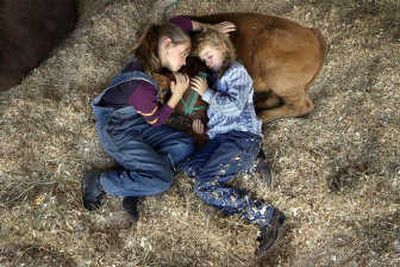‘Harvest Memories’

She never hitched the 27-mule team to the family combine, never trailed behind with needle and twine sewing shut grain sacks as quickly as they filled.
And so Leila Stevens Hickman gauged the harvest differently than the men in her family. She gauged it not in bushels per acre, or by the way the bearded tassels of grain bent on the shaft.
Hickman measured the task by the number of leaves in the dining room table, by the number of potatoes boiling in a pot on the woodstove, by the number of forks and plates required to feed a hungry crew. Those are the 82-year-old’s harvest memories. Hers and others are on display this weekend at the Southeast Spokane County Fair in Rockford. “Harvest Memories” is this year’s fair theme. The fair started Friday and continues through Sunday.
“I can remember it wasn’t unusual for us to have 15 men to cook for,” Hickman said. “Mother made the bread and we’d have meat from the ranch, a roast, steaks, a meatloaf and lots of potatoes. Harvest lasted at least a month.”
When word got out about this year’s fair theme, Hickman dusted off her photo albums and even copied excerpts from her father’s autobiography, “My Life Story,” by Herbert Bolles Stevens. Together, the photographs and story provide a rare glimpse at farm life few remember and even fewer miss.
“It was hard work for the men and the women,” said Gail Kopp, who’s been organizing the fair from the front counter of Rockford Auto, her family business. “I had a guy born on a farm on Mica Peak in here. He told me he worked some header or some machine at 11 years old, a 12-hour-a-day job on a dangerous piece of farm equipment. There were lots of children hurt. I’ve always been romantic about older times, but those were hard times.”
The Stevens family farmed between Rockford and Worley, Idaho. Hickman’s father, in addition to being a farmer and schoolteacher, also was an amateur photographer so the family’s harvests are well illustrated. One photograph shows a towering, nonmotorized combine pulled behind a 27-mule team.
The farm used government mules, the kind the government gave away along with 40 acres to black farmers in Arkansas after the Civil War.
Herbert Stevens was not a fan of mules, which he said in his biography were “wild, wicked and hard to handle.”
“We had them for several years and the only casualty occurred one morning when a hired man got scared from the stall as he was harnessing them before breakfast,” Stevens wrote. “I went in beside the little mare mule and said, ‘Frank, you’ve got to let her know who is boss.’ I called her a sonom a bitch and kicked her in the belly. This she seemed to resent, and she reacted. She kicked me in the belly and called me an equally offensive name in her native tongue. I was very sore and stiff, and when they took me to see Dr. Clanton the next day, he said I had three broken ribs.
“I had gotten her attention all right, but I had not convinced her of my claim to authority. After several years they were traded to a sheep herder for pack mules.
I’ve often wondered how he got along with them.”
Post-mule farming information was provided to the fair by Ardis Dashiell, whose family still works 2,000 acres in the Mount Hope area. They grow grass, hard red and soft white wheat. In the picture, Ardis’ husband, Tom, harvests grain with a pull-type combine hitched to a Cat tractor. A 1947 International Harvester drives alongside, collecting grain that streams from the combine chute like a golden river. That fall of 1947, things couldn’t have been better.
“We had a real good crop. We had 60 bushels to the acre that year, and that was tops. Oh, we’d never seen a crop like that,” Dashiell said. “In ‘48 we had a double crop. We spent it all, had a daughter that year. I made all our clothes. Got 10 yards of flannel and made diapers.”
The basics of farming really haven’t changed since that picture was taken, Dashiell said, with one exception. Farming just got bigger. The year the photo was taken it was just Tom Dashiell and a hired man cutting 240 acres.
“There’s a part of the old harvest I don’t miss,” Dashiell said. “We had hay and I could have eight to 15 men to cook for, and sometimes breakfast, lunch and dinner. I even done their washing.”
But the hard work of the harvest would wind down in the fall, just as summer’s fever finally broke and the kids headed back to school, which for some had to seem almost sinful compared to the sunup to sundown work of bringing in crops. The fourth weekend in September would roll around and the fair would fire up in Rockford. Then like now, admission was free and the event seemed to close out a year known to the farmers and the land, but lost on those in the city.